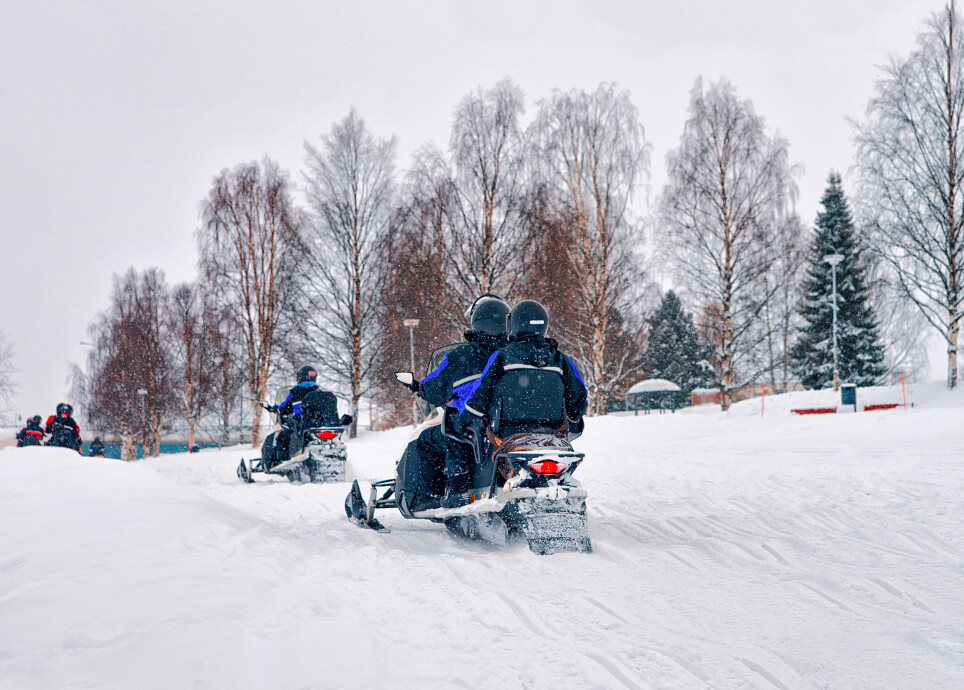THIS ARTICLE/PRESS RELEASE IS PAID FOR AND PRESENTED BY the Norwegian University of Life Sciences (NMBU) - read more

High impact of snowmobile pollution in Svalbard
Snowmobiles in and around Longyearbyen pollute more than the local coal power plant.
“We had expected much higher pollution in winter, when the air transports man-made pollution from Northern European and Asian industrial sources. Furthermore, during the dark Polar Winter, the photosensitive pollutants do not break down as easily due to the lack of sunlight. Local emissions are also greater because of the continuous heating of buildings during winter in Northern Eurasia,” says Tatiana Drotikova.
Local pollution
Drotikova is in the final stages of her PhD at the Norwegian University of Life Sciences (NMBU) in Ås, near the Norwegian capital Oslo, but is located in Longyearbyen, at the University Centre in Svalbard (UNIS).
In Svalbard, she is monitoring emissions of polycyclic aromatic hydrocarbons (PAH). This is a group of compounds comprising roughly two hundred different substances. Exposure to some of these substances can lead to lung cancer, premature births and in average lower birth weights.
“PAHs are occurring in all sorts of incineration processes including combustion of fossil fuels. Here in Longyearbyen, most of PAHs in the air come from cars, snowmobiles, coal transportation and combustion– there isn’t much wood burning,” Drotikova says with a smile.

Cleaner coal power plant
Longyearbyen is home to Norway’s only coal-fired power plant.* Svalbard is home to yet another coal power plant, the second one, however, is located in the Russian mining town of Barentsburg approximately 70 kilometres west of Longyearbyen.
“A new flue gas purification system was installed in the power plant in Longyearbyen in 2015. Even with the purified emissions, the plant is still an important source of pollution. Still, things are looking much better now than before,” she says.
Ninety per cent of the time, the smoke from the power plant blows away from Longyearbyen town.
“We have compared the PAH emission profile of the Longyearbyen power plant to others all over the world, also with power plants that have similar flue gas purification systems. Compared to the other plants, this one is small and very clean, and we can conclude that it has a very good emission cleaning standard,” says Tatiana Drotikova.
Tourists
Tourists, on the other hand, are also considered a major source of pollution, especially during the spring and summer season.
“PAH concentrations are clearly much higher in spring than in winter,” she says, and explains about the snowmobiles:
“In winter, the weather is more varied. Before spring arrives, surface temperatures become extremely low. This means that there is less mixing between the atmospheric layers in the spring, and that the air closest to the ground is isolated from the layers above it,” she says.
When spring comes, the lowest layer is only a hundred metres thick, whereas on mainland, it is often two kilometres thick. This is the layer where pollution needs to be diluted. Instead, the layer becomes a ‘lid’ that locks in the pollution around Longyearbyen, making it surprisingly concentrated.
In Ny-Ålesund, a research station about 120 kilometres North-West of Longyearbyen, there is less snowmobile traffic, and consequently the air is much cleaner.
Summer surprises
“In summer, we expect the polluting compounds to be rapidly degraded since there is sun around the clock and less pollution is being transported over long distances from further south. Many research articles show that the Arctic is clean in summer, but this is not the case in Longyearbyen,” Drotikova states.
Svalbard and Longyearbyen receives many large cruise ships during a normal summer.
“There are 2,400 people living here. Sometimes, the cruise ships bring more than 3,000 passengers with them. Hence, during the summer season the population is more than doubled for short periods. Emissions from the ships also lead to higher PAH concentrations in the local air. But in summer, the atmospheric layer that dilutes pollution is thicker, and the layers mix better,” she says.
How toxic are the emissions?
Similar measurements have never been carried out in Longyearbyen before. That means that Drotikova has nothing to compare her findings with. She also tells us about a wind that changes direction when summer comes. As long as there is snow on the ground, the ground is colder than the neighbouring fjord. In summer, on the other hand, the water is colder than the ground. The wind therefore blows from the fjord towards the shore.
In August, Tatiana Drotikova and her colleagues from Norwegian and Scottish research institutes published a research article where they showed that the coal power plant is a minor PAH source for the local atmosphere compared with other sources of emissions such as traffic and industry. Now they are planning to estimate how toxic the emissions from snowmobiles are.
PS: Drotikova tried to take samples from Barentsburg as well, but the measuring equipment couldn’t handle the large amount of particles in the smoke from the power plant.
* The Norwegian government announced in January 2021 that the coal-fired power plant will be replaced by a more climate friendly solution within the next two to three years.
See more content from NMBU:
-
We're eating more cashew nuts – and the consequences are serious
-
Do young people with immigrant parents have better health?
-
Who’s picking your strawberries this summer?
-
Can coffee grounds and eggshells be turned into fuel?
-
Rising housing costs fuel inequality in Norway
-
Researchers warn: Climate change in African mountains has a greater impact than previously thought





































